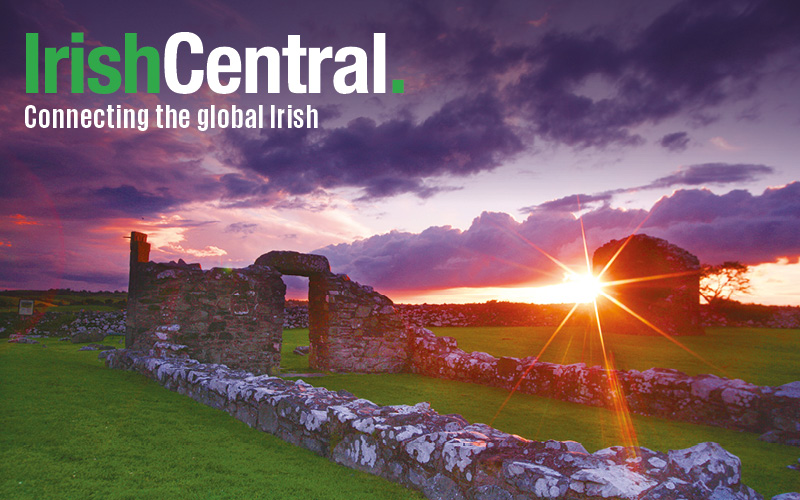| Adult Irish dancer S.J. Velasquez from New York, USA Photo: courtesy S.J. Velasquez |
S.J. Velasquez is an adult Irish dancer, and she writes the blog RincePop here on IrishCentral.com. She started Irish dancing when she was eleven, and recently took up Irish dancing again as an adult. I asked S.J. to share with us her unique perspective on dancing Irish as a teen and an adult. You can read her blog RincePop here.
Christy: How long have you been dancing?
S.J.: I started dancing when I was 11, and I'm now 27. I danced competitively with Rince na Tiarna (Buffalo, N.Y.) through my teen years. After college, I moved to New York City and danced a year, though I did not compete. In 2010, I danced on an adult ceili team for the Johnston School while living and working in Syracuse, N.Y. Now, I'm back in my hometown where I dance for Clann Na Cara, and I'll be one of nine adults proudly representing that school at the Mid-Atlantic Region Oireachtas in November.
Christy: As a dancer who competed as a teen and an adult, have you found the stress of dancing to be harder on your body physically? Do you learn the steps equally as quickly?
S.J.: I actually had a hard time when I was in my early teens. I was definitely a chubby adolescent! I lost a considerable amount of weight in high school and college and that's when dancing was the easiest on my body. I was more flexible, and there was less weight to carry. Since college, my weight fluctuated and body changed, making dance more challenging as the pounds came back. But, to be honest, I am the physically the strongest I've ever been. I now run long distance races (did my second half marathon in May) and have found that the best runners are typically not the younger runners--the best are those who've been training and tuning their bodies over the years. The running scene has given me a new perspective on Irish dance and what our bodies are capable of doing after what's believed to be our physical peak.
S.J.: But I must admit, there were a few years during and after college where I hadn't really danced at all. Getting back into dancing was very awkward and frustrating. It felt like my body couldn't keep up with my brain. Moves and techniques that I once could do without much thought were suddenly very difficult to execute. It wasn't so much my age that was holding me back as it was my lack of practice. I found a really great school in New York City (the Aherne Sheehan School) that helped me get my Irish dance groove back.
Now that I'm back in Buffalo, I feel like I'm dancing just as well, if not better, than ever before. My rhythm has improved, I'm stronger, and I finally feel like dancing is natural to me.
|
S.J. Velasquez and Sarah Culligan, adult Irish dancers
at the recent Young School Feis in Rochester, NY
Photo: courtesy S.J. Velasquez
|
S.J.: Absolutely. As an adult in the media world (I'm a multimedia journalist), I connect with Irish dancers on a whole different level. As a youth, I mingled with friends at dance class and made feis buddies, but I didn't really interact with dancers beyond my region. Now I connect with dancers of all ages and levels from around the world, and I maintain many of those relationships through social networks and travel. I even interviewed my Irish dance idol, Jean Butler, twice in person. It's amazing when you grow up gawking over the stunning beauty that is Riverdance, and suddenly you're interviewing the star of the show.
So, as a teen, my Irish dance circle was very local. Now it's a global network. I look forward to meeting up with international dance friends at events. And I particularly like meeting up with dance friends for an adult beverage after class or performance. Couldn't do that as a teen!
Christy: Do you feel any animosity from others because you dance as an adult?
S.J.: Sadly, yes. I admit that when I was younger, I snickered at the sight of adult beginners. That was completely childish and prejudice of me. I realize now that Irish dance adults are extremely talented and devoted, and they're capable of reaching great heights when their teachers and fellow dancers support them and challenge them. So often, dancers that start later in life are not taken seriously, and they may never reach their full potential. I personally feel just as capable of learning steps and training as I did when I was 14. But there aren't as many people who are willing to take me seriously because of my age.
Lucky for me, I have a tough, but supportive dance teacher at Clann na Cara who constantly challenges me to be a better dancer.
Christy: What do you miss about competition from your teens?
|
Adult Irish dance 4-hand team
for the Johnston School (Syracuse, NY) in 2010
Photo: courtesy S.J. Velasquez
|
Christy: What is the best thing about dancing as an adult?
S.J.: Irish dance has really shaped much of my social life, and it's now more apparent than ever. As an adult, I can appreciate what dancing has done, and continues to do, for me. I was a bridesmaid in my friend Rachel's wedding a few years ago. Rachel and I met through dancing when we were about 13 years old. And my friend Connor took up Irish dance classes with me when we both relocated to New York City. There's something about dancing friends that makes them different from your friends from school or work. It's like the bonds are enhanced because of this common interest and talent.
Irish dance taught me about being a leader, presenting myself in public and sportsmanship. I credit much of that professional training to Mary Kay Heneghan, my former teacher at Rince na Tiarna. These skills have helped me land jobs and grow as an adult.
Also, as an adult, I'm interested in what Irish dance means. These last few years, I've been intrigued by the history of Irish dance and how it's developed over the years. Different styles reflect regional trends and cultural evolution, yet it ties me to a piece of my ancestry. I can identify, in some small way, with my ancestors through dance.
Christy: What do you think the future holds for adults in Irish dance?
S.J.: Adult dancers are getting better and better. I look at schools like O'Rourke (New York) and Tir na nOg (Germany, Russia, etc.), and I'm blown away by how talented the adult dancers are. They prove that Irish dance is something you can enjoy and master at different ages. And based on what I've seen at the Mid-Atlantic Region Oireachtas, the level of talent in the top adult ceili teams is definitely at par with the youth categories. The fact that our region offers adult trad sets at the oireachtas is extremely promising.
|
Outdoor dance jam in Washington Square Park in NYC in 2010
with members of the Sneaky Steppers and Hammerstep.
Photo: courtesy S.J. Velasquez
|
Christy: How long do you intend to Irish dance? Will you drop down in to the "& overs"?
S.J.: Right now, I really don't plan on dropping down to & overs. The competition in adult categories is pretty fierce. My current goals are to place top five in trad sets at the oireachtas and help my ceili teams earn spots on the podium.
I'll dance for as long as I can physically dance. My Irish grandfather (I'm of very mixed ancestry) was always so proud of me for taking up Irish dance. He loved dancing around with me, his only Irish-dancing grandchild. Shortly after having one of his leg's amputated due to a diabetes-related infection, he propped himself up on one leg and hopped around the room while exclaiming, "I can still jig!" I figure, if my grandfather was dancing a one-legged jig, there's no reason I should stop dancing while I have two perfectly good legs.
So how do you feel about dancing when you are an adult, or now that you are an adult? Are there differences that you can see for adult Irish dancers? How do you overcome the differences?
So how do you feel about dancing when you are an adult, or now that you are an adult? Are there differences that you can see for adult Irish dancers? How do you overcome the differences?
* * *
Readers: Are you an adult Irish dancer, competitive or not, with a story to share? Would you like to inspire others to feel your passion for Irish dancing and culture? Do you have a question about Irish dancing? Please visit www.christydorrity.com.




Comments